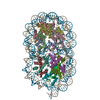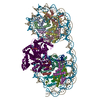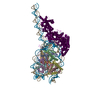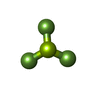[English] 日本語
 Yorodumi
Yorodumi- PDB-9gd1: Structure of Chd1 bound to a hexasome-nucleosome complex with a d... -
+ Open data
Open data
- Basic information
Basic information
| Entry | Database: PDB / ID: 9gd1 | |||||||||
|---|---|---|---|---|---|---|---|---|---|---|
| Title | Structure of Chd1 bound to a hexasome-nucleosome complex with a dyad-to-dyad distance of 103 bp. | |||||||||
 Components Components |
| |||||||||
 Keywords Keywords | DNA BINDING PROTEIN / chromatin / remodeling / transcription / nucleosome | |||||||||
| Function / homology |  Function and homology information Function and homology informationregulation of transcriptional start site selection at RNA polymerase II promoter / nucleolar chromatin / negative regulation of DNA-templated DNA replication / regulation of chromatin organization / SLIK (SAGA-like) complex / rDNA binding / DNA double-strand break processing / nucleosome organization / ATP-dependent chromatin remodeler activity / SAGA complex ...regulation of transcriptional start site selection at RNA polymerase II promoter / nucleolar chromatin / negative regulation of DNA-templated DNA replication / regulation of chromatin organization / SLIK (SAGA-like) complex / rDNA binding / DNA double-strand break processing / nucleosome organization / ATP-dependent chromatin remodeler activity / SAGA complex / sister chromatid cohesion / termination of RNA polymerase II transcription / termination of RNA polymerase I transcription / : / ATP-dependent activity, acting on DNA / transcription elongation by RNA polymerase II / helicase activity / double-strand break repair via homologous recombination / chromatin DNA binding / Hydrolases; Acting on acid anhydrides; Acting on acid anhydrides to facilitate cellular and subcellular movement / structural constituent of chromatin / nucleosome / heterochromatin formation / nucleosome assembly / site of double-strand break / histone binding / transcription cis-regulatory region binding / chromatin remodeling / protein heterodimerization activity / chromatin binding / regulation of transcription by RNA polymerase II / chromatin / ATP hydrolysis activity / mitochondrion / DNA binding / nucleoplasm / ATP binding / nucleus Similarity search - Function | |||||||||
| Biological species | synthetic construct (others)  | |||||||||
| Method | ELECTRON MICROSCOPY / single particle reconstruction / cryo EM / Resolution: 4 Å | |||||||||
 Authors Authors | Engeholm, M. / Roske, J.J. / Oberbeckmann, E. / Dienemann, C. / Lidschreiber, M. / Cramer, P. / Farnung, L. | |||||||||
| Funding support |  Germany, European Union, 2items Germany, European Union, 2items
| |||||||||
 Citation Citation |  Journal: Mol Cell / Year: 2024 Journal: Mol Cell / Year: 2024Title: Resolution of transcription-induced hexasome-nucleosome complexes by Chd1 and FACT. Authors: Maik Engeholm / Johann J Roske / Elisa Oberbeckmann / Christian Dienemann / Michael Lidschreiber / Patrick Cramer / Lucas Farnung /    Abstract: To maintain the nucleosome organization of transcribed genes, ATP-dependent chromatin remodelers collaborate with histone chaperones. Here, we show that at the 5' ends of yeast genes, RNA polymerase ...To maintain the nucleosome organization of transcribed genes, ATP-dependent chromatin remodelers collaborate with histone chaperones. Here, we show that at the 5' ends of yeast genes, RNA polymerase II (RNAPII) generates hexasomes that occur directly adjacent to nucleosomes. The resulting hexasome-nucleosome complexes are then resolved by Chd1. We present two cryoelectron microscopy (cryo-EM) structures of Chd1 bound to a hexasome-nucleosome complex before and after restoration of the missing inner H2A/H2B dimer by FACT. Chd1 uniquely interacts with the complex, positioning its ATPase domain to shift the hexasome away from the nucleosome. In the absence of the inner H2A/H2B dimer, its DNA-binding domain (DBD) packs against the ATPase domain, suggesting an inhibited state. Restoration of the dimer by FACT triggers a rearrangement that displaces the DBD and stimulates Chd1 remodeling. Our results demonstrate how chromatin remodelers interact with a complex nucleosome assembly and suggest how Chd1 and FACT jointly support transcription by RNAPII. | |||||||||
| History |
|
- Structure visualization
Structure visualization
| Structure viewer | Molecule:  Molmil Molmil Jmol/JSmol Jmol/JSmol |
|---|
- Downloads & links
Downloads & links
- Download
Download
| PDBx/mmCIF format |  9gd1.cif.gz 9gd1.cif.gz | 664.7 KB | Display |  PDBx/mmCIF format PDBx/mmCIF format |
|---|---|---|---|---|
| PDB format |  pdb9gd1.ent.gz pdb9gd1.ent.gz | Display |  PDB format PDB format | |
| PDBx/mmJSON format |  9gd1.json.gz 9gd1.json.gz | Tree view |  PDBx/mmJSON format PDBx/mmJSON format | |
| Others |  Other downloads Other downloads |
-Validation report
| Summary document |  9gd1_validation.pdf.gz 9gd1_validation.pdf.gz | 977.9 KB | Display |  wwPDB validaton report wwPDB validaton report |
|---|---|---|---|---|
| Full document |  9gd1_full_validation.pdf.gz 9gd1_full_validation.pdf.gz | 1004.1 KB | Display | |
| Data in XML |  9gd1_validation.xml.gz 9gd1_validation.xml.gz | 63.5 KB | Display | |
| Data in CIF |  9gd1_validation.cif.gz 9gd1_validation.cif.gz | 103.4 KB | Display | |
| Arichive directory |  https://data.pdbj.org/pub/pdb/validation_reports/gd/9gd1 https://data.pdbj.org/pub/pdb/validation_reports/gd/9gd1 ftp://data.pdbj.org/pub/pdb/validation_reports/gd/9gd1 ftp://data.pdbj.org/pub/pdb/validation_reports/gd/9gd1 | HTTPS FTP |
-Related structure data
| Related structure data |  51241MC  9gd0C  9gd2C  9gd3C C: citing same article ( M: map data used to model this data |
|---|---|
| Similar structure data | Similarity search - Function & homology  F&H Search F&H Search |
- Links
Links
- Assembly
Assembly
| Deposited unit | 
|
|---|---|
| 1 |
|
- Components
Components
-Protein , 5 types, 15 molecules AEKOBFLPCGMDHNW
| #1: Protein | Mass: 15435.126 Da / Num. of mol.: 4 Source method: isolated from a genetically manipulated source Source: (gene. exp.)  #2: Protein | Mass: 11394.426 Da / Num. of mol.: 4 Source method: isolated from a genetically manipulated source Source: (gene. exp.)  #3: Protein | Mass: 14109.436 Da / Num. of mol.: 3 Source method: isolated from a genetically manipulated source Source: (gene. exp.)  #4: Protein | Mass: 13655.948 Da / Num. of mol.: 3 Source method: isolated from a genetically manipulated source Source: (gene. exp.)  #7: Protein | | Mass: 168496.609 Da / Num. of mol.: 1 Source method: isolated from a genetically manipulated source Source: (gene. exp.)   Trichoplusia ni (cabbage looper) Trichoplusia ni (cabbage looper)References: UniProt: P32657, Hydrolases; Acting on acid anhydrides; Acting on acid anhydrides to facilitate cellular and subcellular movement |
|---|
-DNA chain , 2 types, 2 molecules IJ
| #5: DNA chain | Mass: 80159.945 Da / Num. of mol.: 1 Source method: isolated from a genetically manipulated source Source: (gene. exp.) synthetic construct (others) / Production host: synthetic construct (others) |
|---|---|
| #6: DNA chain | Mass: 81036.531 Da / Num. of mol.: 1 Source method: isolated from a genetically manipulated source Source: (gene. exp.) synthetic construct (others) / Production host: synthetic construct (others) |
-Non-polymers , 3 types, 3 molecules 




| #8: Chemical | ChemComp-ADP / |
|---|---|
| #9: Chemical | ChemComp-BEF / |
| #10: Chemical | ChemComp-MG / |
-Details
| Has ligand of interest | N |
|---|
-Experimental details
-Experiment
| Experiment | Method: ELECTRON MICROSCOPY |
|---|---|
| EM experiment | Aggregation state: PARTICLE / 3D reconstruction method: single particle reconstruction |
- Sample preparation
Sample preparation
| Component | Name: Chd1 bound to a hexasome-nucleosome complex with a dyad-to-dyad distance of 103 bp Type: COMPLEX / Entity ID: #1-#7 / Source: RECOMBINANT |
|---|---|
| Source (natural) | Organism:  |
| Source (recombinant) | Organism:  Trichoplusia ni (cabbage looper) Trichoplusia ni (cabbage looper) |
| Buffer solution | pH: 7.4 |
| Specimen | Embedding applied: NO / Shadowing applied: NO / Staining applied: NO / Vitrification applied: YES |
| Vitrification | Cryogen name: ETHANE |
- Electron microscopy imaging
Electron microscopy imaging
| Experimental equipment |  Model: Titan Krios / Image courtesy: FEI Company |
|---|---|
| Microscopy | Model: FEI TITAN KRIOS |
| Electron gun | Electron source:  FIELD EMISSION GUN / Accelerating voltage: 300 kV / Illumination mode: FLOOD BEAM FIELD EMISSION GUN / Accelerating voltage: 300 kV / Illumination mode: FLOOD BEAM |
| Electron lens | Mode: BRIGHT FIELD / Nominal defocus max: 2000 nm / Nominal defocus min: 500 nm |
| Image recording | Electron dose: 39.8 e/Å2 / Film or detector model: GATAN K3 (6k x 4k) |
- Processing
Processing
| CTF correction | Type: PHASE FLIPPING AND AMPLITUDE CORRECTION |
|---|---|
| 3D reconstruction | Resolution: 4 Å / Resolution method: FSC 0.143 CUT-OFF / Num. of particles: 26819 / Symmetry type: POINT |
| Refinement | Cross valid method: NONE |
 Movie
Movie Controller
Controller














 PDBj
PDBj









































